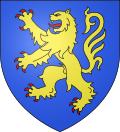References
- ↑ Thomas Thomson, A Diurnal of Remarkable Occurrents in Scotland (Bannatyne Club, 1833), pp. 102-3.
John III, Count of Ligny Died: 1 July 1576 | ||
| Preceded by | Count of Ligny Count of Brienne 1557-1576 | Succeeded by |
| House of Brienne | ||
|---|---|---|
| House of Enghien | ||
| House of Luxemburg | ||
| House of Loménie | ||
| | This article about a French count is a stub. You can help Wikipedia by expanding it. |
